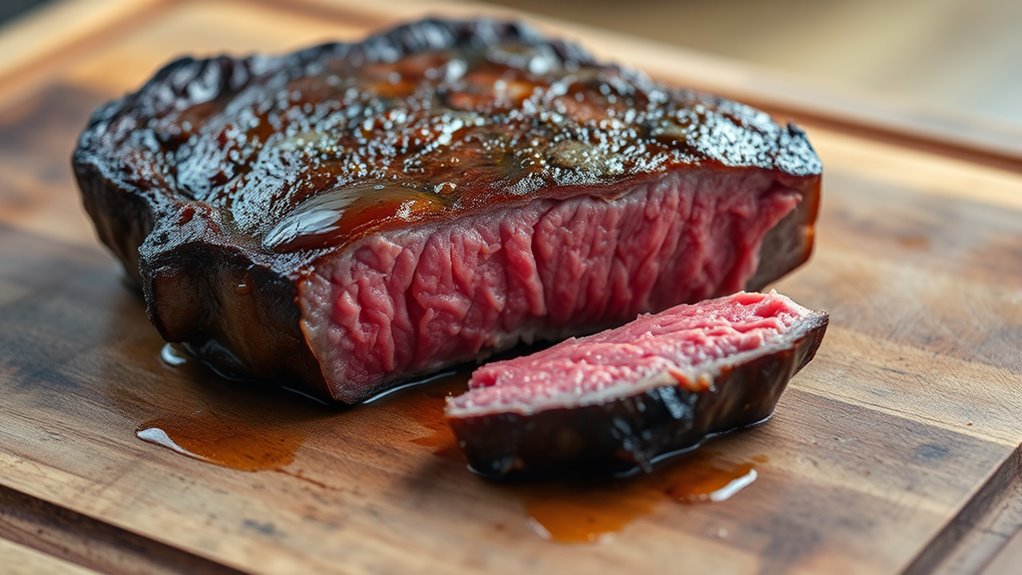Resting meat is essential because it lets the juices, driven toward the center during cooking, settle back evenly throughout the cut. This step prevents juices from escaping when you cut into it, ensuring a moist, flavorful bite. Without resting, your meat can turn out dry and less tender. By understanding how carryover heat affects internal temperature, you can perfect your process. Keep going to discover how mastering resting time can make your meats truly outstanding.
Key Takeaways
- Resting allows juices to redistribute evenly, preventing them from spilling out when meat is cut.
- It helps juices settle back into meat fibers, enhancing moisture and overall tenderness.
- Resting time reduces juice loss, resulting in a more flavorful and juicy bite.
- It compensates for carryover cooking, avoiding overcooking and dryness.
- Proper resting improves meat texture, flavor, and visual appeal by ensuring consistent internal juices.

Resting meat is a critical step in achieving perfect, juicy results after cooking. When you take your meat off the heat, it doesn’t instantly stop cooking. Instead, residual heat continues to raise the meat’s temperature through a process known as carryover cooking. This phenomenon can add a few extra degrees to your meat’s internal temperature, which is why timing your rest is essential. If you cut into your meat too soon, you risk losing those flavorful juices that have begun to redistribute during resting. Conversely, if you wait too long, the meat might cool down excessively, diminishing its ideal texture. By understanding how carryover cooking affects meat temperature, you can better plan your resting period to guarantee your meat stays tender and flavorful.
Resting meat ensures juices redistribute and carryover cooking reaches perfect doneness.
When you remove the meat from the heat, the internal temperature continues to rise slightly due to carryover cooking, often by 5 to 10 degrees Fahrenheit, depending on the size and thickness of the cut. This rise is especially important for large roasts or thicker steaks, where the internal temperature can increase considerably even after removing from the grill or oven. If you don’t account for this, you might end up overcooking your meat, making it dry or tough. To prevent this, you should pull the meat from the heat when it’s a few degrees below your target temperature. This way, as carryover cooking occurs during the rest, the meat reaches the perfect finish you’re aiming for.
Resting also allows the juices, which are driven to the center during cooking, to redistribute evenly throughout the meat. If you cut into your meat immediately after cooking, those juices will escape, leaving you with a dry, less flavorful piece. During rest, the juices settle back into the fibers, resulting in a more moist and tender bite. The key is to give the meat enough time—usually 5 to 20 minutes depending on the size—to let this juice redistribution happen. Covering the meat loosely with foil can help retain heat while it rests, ensuring that carryover cooking continues gently without cooling the meat too much. Additionally, understanding the size and thickness of your meat can help you determine the optimal resting time for best results.
Ultimately, paying attention to meat temperature and understanding carryover cooking will elevate your cooking game. Resting isn’t just about letting the meat sit; it’s a strategic step that influences the final texture, juiciness, and flavor. When you master the timing, you’ll consistently serve meat that’s perfectly cooked, tender, and bursting with flavor—just the way it should be.
Frequently Asked Questions
How Long Should I Rest Different Types of Meat?
You should rest different meats based on their thickness and cooking temperature. For steaks, rest for 5-10 minutes, especially if thick, to allow juices to redistribute. Roasts need about 15-20 minutes, depending on size. Poultry generally rests for 10-15 minutes. Adjust resting times if your meat was cooked at higher temperatures or is thicker, as these factors influence how long you should wait before slicing to keep it juicy.
Does Resting Meat Affect Its Flavor?
Think of resting meat as giving a symphony time to settle before the final note. When you let it rest, you allow flavor enhancement and juiciness preservation, making each bite more flavorful and tender. Resting helps the juices redistribute evenly, preventing them from spilling out when you cut into it. So, yes, resting meat definitely affects its flavor—improving richness and ensuring every mouthful is juicy and delicious.
Is There a Risk of Bacteria Growth During Resting?
You might wonder if resting meat risks bacterial growth, but as long as you follow proper food safety guidelines, it’s safe. Resting meat at room temperature for a short period doesn’t substantially increase bacterial growth, especially if you keep it covered and in a warm, clean environment. To guarantee safety, avoid resting for too long, and always use a food thermometer to check that the internal temperature remains safe before serving.
Can Resting Meat Improve Its Tenderness?
Yes, resting meat can improve its tenderness. When you let meat rest, juice redistribution occurs, allowing the muscle fibers to relax and absorb moisture. This process reduces the loss of juices when slicing, resulting in a juicier, more tender bite. By giving meat time to rest, you enhance meat tenderness and ensure a better eating experience, as the fibers settle and the flavors deepen.
Should I Cover Meat While Resting?
Think of resting meat like letting a storm settle; covering it helps control the temperature and keeps the juices in. You should loosely tent it with foil, not wrap tightly, to prevent trapping steam that could make the crust soggy. Resting at room temperature or slightly warm helps juices redistribute evenly. Proper meat storage before cooking also impacts the final result, ensuring your meat stays flavorful and tender.
Conclusion
Remember, resting meat is like letting a story settle before sharing it—things need time to come together perfectly. I once cooked a roast, cut into it immediately, and lost all those flavorful juices. But after resting, it was like opening a well-shaken soda—everything redistributes, juicy and delicious. So, trust the science: give your meat a few minutes to rest, and you’ll enjoy a tender, flavorful bite every time. Patience truly makes the difference.









